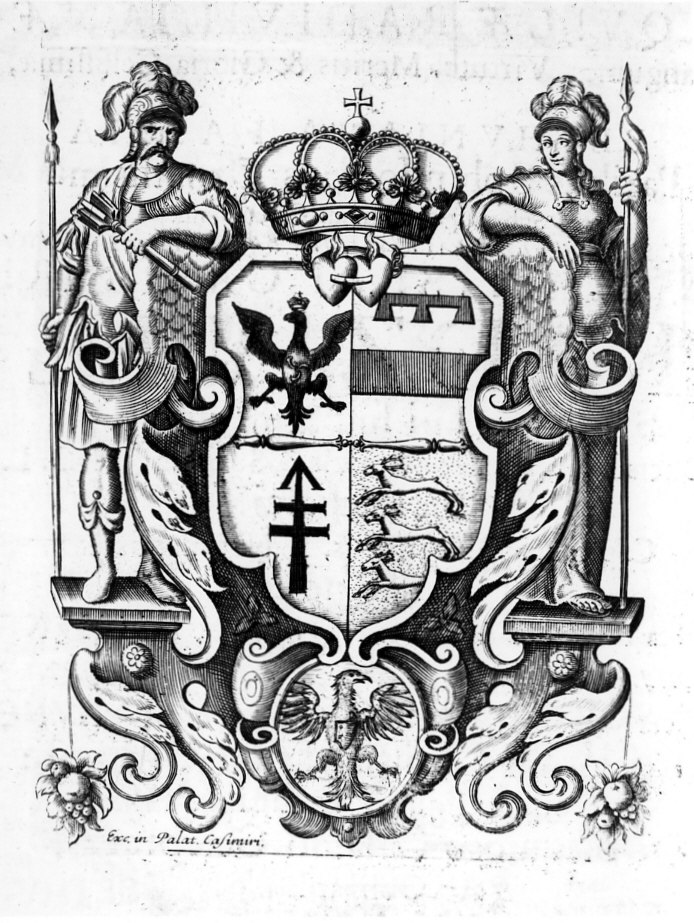
Charles (Carl) de La Haye was a French copperplate engraver born in Fontainebleau in 1641. Having spent some time in Rome and Florence, in ca. 1682 he made his way to Gdańsk where he settled and was artistically active until 1689, printing inter alia effigies of patricians, chiefly for funeral speeches. After this date he left for Warsaw and easily blended in the new milieu. He made friends with painter Jerzy Eleuter Szymonowicz-Siemiginowski, a beneficiary of Jan III Sobieski’s patronage and the head of the Wilanów painters atelier. The two artists were accommodated in the premises of the Kazimierzowski Palace (or an adjacent building, part of the palace complex) and thus remained under the tutelage of Prince Jakub Ludwik. Publishing addresses found in some of La Haye’s prints (Exc. In Palat. Casimiri; Venduntur apud eundem auctorem in Palatio Casimiri Varsaviae) testify that he single-handedly impressed, published and sold his works. His prints were usually chased on the basis of paintings and drawings by Siemiginowski and depicted Jan III and other royal family members. The most famous are heroic portraits of King Sobieski – bust representations in an antique-looking armour (two versions: the so-called large one from ca. 1690, dedicated to Marie Casimire, and the so-called small one from 1692, included in two prints: Questio Juridica by Andrzej Grzegorz Krupecki, Cracoviae 1692, and Schauplatz der Zeit by A. von Ziegler, Leipzig 1695) as well as the equestrian portrait against the background of Vienna (1692?).
Regrettably lost during the World War II was a portrait of Marie Casimire executed also on the basis of a drawing by Siemiginowski, part of the Załuski collection, recorded in the National Library as late as in 1933. La Haye printed additionally the title page of Mikołaj Chwałkowski’s work Effata Regum Poloniae (Varsaviae 1694), depicting a session of the Polish Sejm gathered in the Warsaw Royal Castle with senators and Jan III seated on the throne. Three years later La Haye made use of another of Siemiginowski’s drawings, this time to portray Prince Jakub Ludwik as a personification of the Polish Liberty. The print was commissioned by the prince himself when he was aspiring for the crown, and illustrated Stanisław Orzechowski’s publication Subditus fidelis (Varsaviae 1698). Somewhat less known are La Haye’s heraldic prints, for instance two decorative cartouches functioning as pendants, which depict the White Eagle bearing on its chest the Sobieskis’ Janina as well as the coat of arms of d’Arquien family (1693). Likewise, four coats of arms (including among others that of d’Arquien family, the Radziwiłłs’ Trumpets and the Sapiehas’ Fox) inscribed in a common cartouche, included in the printed work entitled Triumphus Aquilae Radivilianae (Varsaviae 1690). After 1699 La Haye (one of the leading engravers active in contemporary Warsaw) left the Polish capital and moved to Vienna, probably with Marcin Altomonte. The date of his death is unknown.
Charles (Carl) de La Haye: Heraldic print for Triumphus Aquilae Radivilianae, copperplate engraving, publ. 1690.
We would like to inform that for the purpose of optimisation of content available on our website and its customisation according to your needs, we use information stored by means of cookies on the Users' end devices. You can control cookies by means of your Internet browser settings. Further use of our website without change of the browser settings means that you accept the use of cookies. For more information on cookies used by us and to feel comfortable about this subject, please familiarise yourselves with our Privacy Policy.
✓ I understand